Last Updated on March 11, 2024 by Kittredge Cherry
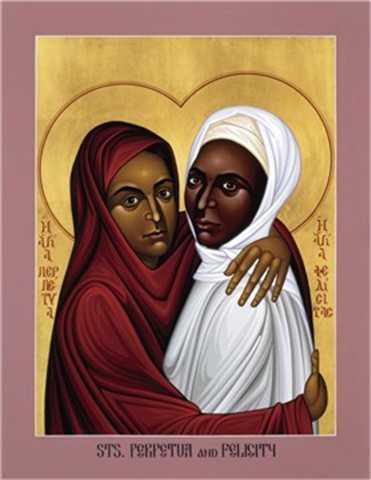
Perpetua and Felicity are 3rd-century North African paired saints who were executed together for their Christian faith. Some consider them lesbian saints or patrons of same-sex couples. Transgender people also draw inspiration from Perpetua because she had a queer vision of being transformed into a man. They were arrested for being Christian, imprisoned together, and kissed each other in the last moments before they were both put to death in the the so-called “games” of public arena in Carthage on March 7, 203.
The details of their imprisonment are known because Perpetua kept a journal, which is considered the first known written document by a woman in Christian history and one of the only known texts by a woman in the whole ancient world.
Perpetua and Felicity share a March 7 feast day in the Roman Catholic and some Protestant traditions. It always falls right before International Women’s Day (March 8) during Women’s History Month (March). Their feast day is Feb. 1 in the Eastern Orthodox church.
The two women are still admired both inside and outside the church for their extraordinary faith and courage in the face of death. They are named together in the Canon of the Mass, the fundamental Roman Catholic prayer recited by the priest during the Eucharist. Perpetua and Felicity championed freedom of conscience at a time when it was considered treason to refuse to worship the Roman gods, including the emperor. They are the earliest post-Biblical paired saints and have appeared together as a female couple in countless icons over the centuries. The women are often depicted with a cow, and Perpetua is the patron saint of cattle.
For centuries, people have been fascinated by the story of the two courageous women comforting each other in jail and giving each other the kiss of peace as they met their end in the amphitheater at Carthage. They were exposed to a wild cow before being beheaded. Perpetua’s diary was read aloud annually in Carthage’s churches for centuries. In fact, it was so revered in fourth-century North Africa that Augustine of Hippo warned people not to treat it like the Bible.
Yale history professor John Boswell named Perpetua and Felicity as one of the three primary pairs of same-sex saints in the early church in his book “Same Sex Unions in Pre-Modern Europe” (The others are male pairs Polyeuct and Nearchus and Sergius and Bacchus.)
Perpetua and Felicity are often included in lists of LGBTQ saints because they demonstrate the power of love between two women. The fact that they were both young mothers proves that they had sexual contact with men, but it’s also possible that they had a homoerotic or romantic connection with each other. Although Perpetua was married, her husband is conspicuously absent from her diary. “A young woman’s marriage in second- or third-century Rome did not necessarily indicate anything about the direction of her affections,” Boswell writes.
New in 2024: Icons show Perpetua and Felicity
Q Spirit is introducing two new icons of Perpetua and Felicity for their feast day in 2024. At the same time, a new section called “Perpetua moved beyond gender with a trans vision” was added to this article.
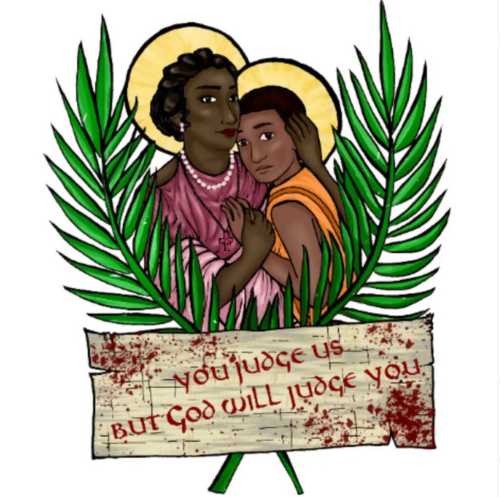
“Saints Perpetua and Felicity” by Faithful Heretic
Perpetua and Felicity are depicted as a butch/femme lesbian couple clasping hands in a 2023 icon by the artist known as Faithful Heretic. They appear with a blood-spattered sign that declares, “You judge us but God will judge you.” The couple spoke this bold statement to the official in charge of their execution in Perpetua’s account, but it fits strikingly well in a contemporary LGBTQ context. Faithful Heretic describes the couple as “matron saints, a word which takes men out of the equation altogether.” Raised Mormon, Faithful Heretic is an Episcopalian lay minister and a lifelong student of history, especially medieval history and LGBTQ history.
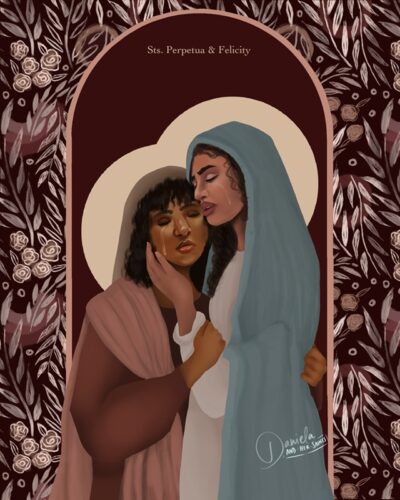
“Saints Perpetua and Felicity” by Daniela of And Her Saints
Perpetua and Felicity share a halo and a tearful embrace in an icon by Daniela, an LGBTQ-affirming Catholic artist based in California. The icon is available at the And Her Saints Etsy shop, where she describes the pair as “unofficially recognized as patrons of sapphic relationships.” Her work is also featured on the And Her Saints Instagram account.
Perpetua’s journal: A coming-out story?
Perpetua’s prison diary is called “The Passion of Saints Perpetua and Felicity.” In some ways Perpetua’s journal reads like a coded coming-out story. She embraces an alternative community, wins arguments with her father, leaves her husband and gives up her baby. She goes on to see herself as male in a vision, moving beyond gender or overcomes gender limitations. Perpetua stands by the woman she loves until they are parted by death.
Her pagan father is upset by her stubborn independence and rejection of her mainstream upbringing, marriage, wealth and privilege. But she out-argues him on three different occasions. “I cannot be called anything other than what I am, a Christian,” she insists. Christianity was extremely countercultural back then, and offered more egalitarian alternatives to the traditional heterosexual family and the rigid Roman class structure. In prison Perpetua may have broken away from some church authority and rules even as she sought to follow God’s will.
Perpetua and Felicity joined a thriving Christian community
Virtually everything known about Perpetua comes from her very own journal. Her full name was Vibia Perpetua, indicating Roman citizenship. Perpetua was a well-educated noblewoman, and a nursing mother from a wealthy family in Carthage (near contemporary Tunis, Tunisia). She was only 22 when she died. Felicity, also known as Felicitas, was an enslaved woman who gave birth to a daughter while they were in prison. It’s not known whether they met through the church or were already acquainted. There is no explicit mention of them being lesbians, but they obviously shared a close bond and deep spiritual connection despite their differences.
Carthage was a large, prosperous city and one of the most important trading hubs of on the Mediterranean Sea. Perpetua and Felicity were members of Carthage’s thriving Christian community, which also included the important theologian Tertullian. They became “catechumens” or people in the three-year process of preparing for baptism. Their church was booming even though the law required everyone to worship the Roman gods of the state religion. Everyone had to honor the emperor as divine — or be put to death.
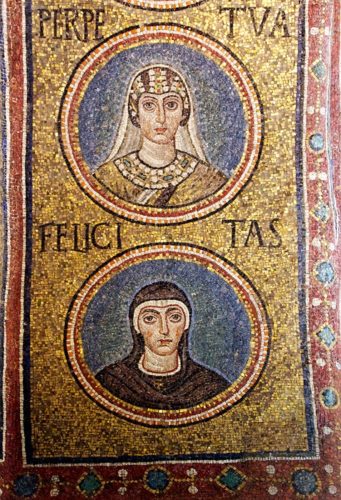
Mosaics of Perpetua and Felicity at Archiepiscopal Chapel in Ravenna, Italy. Sixth century. Photo by Nick Thompson.
As an enslaved woman, Felicity gets less attention when their story is retold. She may have been a foreigner, since many slaves in Carthage came from conquered peoples. Perpetua was not necessarily Felicity’s boss — although some interpreters assume it. The original text is unclear on whether Felicity served Perpetua or somebody else. Their relationship differs from some Christian narratives of male same-sex love where one man is clearly the master or owner of the other, as in the Centurion and his “boy” or Good King Wenceslas and his servant Podivan.
If Perpetua and Felicity were a lesbian couple, their exceptional love broke class barriers as well as prohibitions on homosexuality. Could sexual love between women of different classes be anything other than abuse of power? “If the relationship were to have been erotic, the power imbalance between a slave woman and an elite woman raises the question whether we would need to classify the sexual contact as sexual abuse, especially since the sexual use of slaves was commonplace in the Roman Empire,” Bernadette Brooten writes in “Love Between Women: Early Christian Responses to Female Homoeroticism.”
In 203 Hilarion, the governor of Carthage, was enforcing an edict from Roman emperor Septimius Severus forbidding conversion to Christianity or Judaism. Perpetua and the pregnant Felicity were arrested along with three male catechumens: free men Saturninus and Secundulus, and enslaved man Revocatus. Another man, named Saturus, turned himself in and joined them in prison. All six were found guilty, refused to renounce their faith, and were sentenced to be killed by wild beasts in the arena, although Secundulus died in prison before he could be executed. The four male friends who died with Perpetua and Felicity did not capture the public imagination and have been almost forgotten.
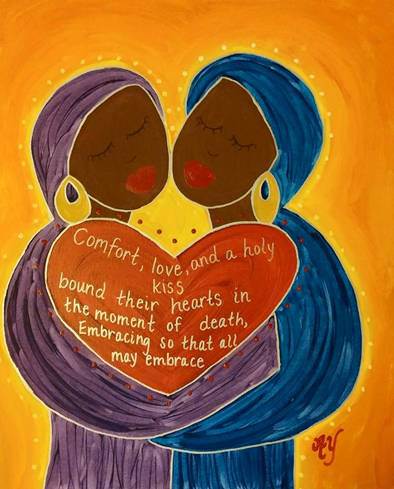
“Perpetua and Felicity” by Angela Yarber. Prints are available at her shop on Fine Art America.
“The Passion of Saints Perpetua and Felicity” begins with their arrest. Perpetua’s prison diary forms the core of the text, but the prologue and ending were written by an anonymous editor or narrator who claims to be an eyewitness. Some suggest that the unnamed editor was Tertullian. Perpetua wrote in Latin, sharing private experiences in a vivid, personal style with emotional immediacy. She begins by telling how she triumphed beat her father in a fight over her faith. She is taken to prison with her infant son. She describes her trial and the hardships of prison life, including the difficulties of breastfeeding or not being allowed to breastfeed her infant son. She triumphs over her father in several more fights and willingly relinquishes her baby to him. Perpetua devotes much of her journal to her prophetic visions. The first involves a bronze ladder, and then she has two visions about her brother who died at age seven. Her fourth, final and most famous vision, Perpetua has a queer experience: She is transformed into a man.
Perpetua moved beyond gender with a trans vision
Both Felicity and Perpetua are praised for their courage as “the most manly of soldiers” in some translations of the original commentary at the end of Perpetua’s diary. But the most dramatic evidence of Perpetua’s transgender aspect is the genderbending vision where she sees herself enter the gladiatorial arena. “Handsome young men” come up to serve as assistants. They strip away her clothes for battle. Perpetua looks at her naked body and exclaims, “Suddenly I was a man (masculus)” (The Martyrdom of Perpetua 3.2). The assistants proceeded to rub Perpetua’s nude body with oil as was customary before battle. The rubdown is ripe with eroticism, even male-male homoeroticism. As a male warrior or gladiator, Perpetua goes on to fight and win a brutal physical fight with an Egyptian man who was “horrible in appearance.”
Perpetua lived in a patriarchal society where turning into a man meant becoming strong and superior with a higher moral and spiritual state. For example, the influential early theologian Augustine preached at least three sermons on Perpetua and Felicity, praising the way a “manly spirit” overcame their supposed female fragility.
But Perpetua’s vision may have been more than a misogynist metaphor for strength. Early Christian texts envision freedom from all gender as holy. The apostle Paul wrote in the Bible that “there is neither male nor female; for you are all one in Christ Jesus” (Galatians 3:28). In the Gospel of Thomas, Jesus says, “When you make the male and the female into a single one, so that the male is not male and the female not female… then shall you enter [the kingdom]” (Gospel of Thomas, Saying 22). The apocryphal Gospel of Thomas may have been written during Perpetua and Felicity’s lifetime.
Perpetua became a precursor and prototype for a particular pattern of faith journey experienced by some women and others who were assigned female at birth: Their faith led them to adopt some queer attributes or adopt whole male identities by rejecting heterosexual marriage, dreaming of being male, cutting their hair, wearing male clothing, changing their names, and eventually living as monks or male hermits. Perpetua’s path is later echoed and expanded by saints, martyrs and ascetics such as Joan of Arc, Marinos / Marina the Monk and other transgender or crossdressing saints.
Felicity gave birth in prison
Perpetua’s part of the text is followed by a third writer’s vision of travelling to heaven with her. It is attributed to Saturus, who may have been their teacher and possibly a priest. Some speculate that Felicity was the original source of the vision. If she envisioned going to heaven with Perpetua, her name would probably have been replaced because enslaved women were not supposed to receive visions. It’s important to compensate for the bias that downplayed her side of the story.
The closing narrative goes into much detail about Felicity giving birth. She was eight months pregnant and eager to deliver her baby so she could die with her friends. Even the Romans would not publicly punish a pregnant woman, so she feared that she would be separated from the group and her execution delayed. Likewise her friends did not want to leave behind “so good a friend and as it were their fellow-traveler on the road of the same hope.” Three days before they were scheduled to die, the prisoners joined in prayer for her to give birth. Their prayers were answered and she immediately went into labor. Perpetua assisted Felicity with the premature birth in this difficult and dangerous situation. While the guards taunted Felicity, she gave birth to a girl, who was adopted by another Christian woman.
Perpetua and Felicity kissed before dying
Roman custom allowed the condemned to choose the food for their last meal. Perpetua, Felicity and their friends decided to make it into an agape love feast, an early Christian eucharistic meal in remembrance of Jesus’ Last Supper. The specific foods of their communion meal are not listed, but it probably included regional staples such as bread, wine, olives, vegetables, and perhaps some cheese or fruit.
“One of the most interesting aspects of this account is the absence of ecclesiastical influence…. In their actions and visions, this group of young martyrs has bypassed contemporary church teaching by baptizing themselves, experiencing mystical baptism, confirmation and eucharist, and sharing inter-gender fellowship,” Brenda M. Johnson explained in an article on the website of Mount Saint Agnes Theological Center for Women.
What follows in the text is literally a long, blow-by-blow account of their torture and death in the arena, where a savage female cow is sent to attack Peretua and Felicity. The unusual choice of a heifer to was made as a cruel joke to mock and call attention to their gender. The cow left them wounded, but still standing together. The women kissed each other before they were beheaded. To Perpetua and Felicity, this was not an unhappy ending. They met their Christ-like death with joy, courage and faith.
Perpetua and Felicity have lasting impact
Such gruesome executions were intended to stop the church, but they had the opposite effect. Instead, they won more converts and spread Christianity. People were impressed by the faith of martyrs who stood up to Roman power and death itself. “The blood of martyrs is the seed of the church,” wrote Tertullian, Perpetua’s contemporary and perhaps the eyewitness editor who completed her manuscript.
The Romans publicly executed thousands of Christians over 250 years, but the persecution ended in 313 when they gave in and granted legal recognition to Christianity. At that time the anniversary of Perpetua and Felicity’s martyrdom was already on the official calendar of the Roman church. Seeing them as patron saints of same-sex couples is a new and controversial development in their long history. Sebastian, probably the most popular saint in the LGBTQ community, was also an early Christian martyr. The lives of the martyrs have never ceased to be a source of fascination and inspiration. The collective memory of their resistance to persecution, suffering and deaths has shaped Christian culture and identity to this day.
Artists portray Perpetua and Felicity
At the top of this post is an icon of the loving same-sex pair by Robert Lentz, a Franciscan friar and world-class iconographer known for his progressive icons. It is rare to see an icon about the love between women, especially two dark-skinned African women. The rich reds and heart-shaped double-halo make it look like a holy Valentine. It appears along with a detailed historical account of their love story in the book “Passionate Holiness: Marginalized Christian Devotions for Distinctive People” by Dennis O’Neill. O’Neill is founder of the Living Circle, the interfaith LGBTQ spirituality center that commissioned the well-known icon of Perpetua and Felicity by Robert Lentz.
 This same icon also appears on the cover of the classic LGBTQ Christian book, “The Queer Bible Commentary,” edited by Deryn Guest, Robert Shore-Goss and Mona West. Prints of “Saints Perpetua and Felicity” by Robert Lentz are available through Amazon and Trinity Stores.
This same icon also appears on the cover of the classic LGBTQ Christian book, “The Queer Bible Commentary,” edited by Deryn Guest, Robert Shore-Goss and Mona West. Prints of “Saints Perpetua and Felicity” by Robert Lentz are available through Amazon and Trinity Stores.
“Perpetua and Felicity” is one of 40 icons featured in “Christ in the Margins,” an illustrated book by Robert Lentz and Edwina Gateley.
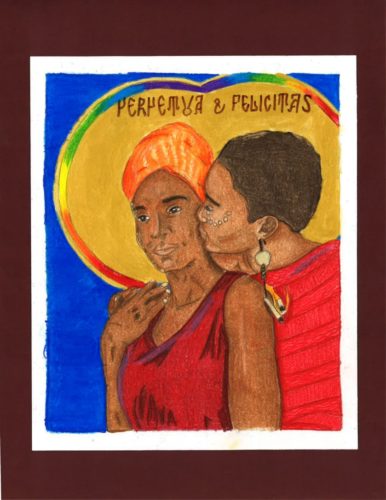
“Perpetua and Felicitas” by Katy Miles-Wallace of the Queerly Christian Zazzle shop.
Most historical images of Perpetua and Felicity portray them with light skin. Some contemporary artists have emphasized their African roots by portraying them with dark skin.
Perpetua and Felicity share a rainbow halo in an icon created in 2017 by queer Lutheran artist and seminarian Katy Miles-Wallace as part of her “Queer Saints” series. The series presents traditional saints with queer qualities and heroes of the LGBTQ community.
The icons are rooted in queer theology and in Miles-Wallace’s eclectic faith journey that began at a Baptist church in Texas and led to study at Pacific Lutheran Theological Seminary in Berkeley, California. She drew many of them on the altar of a seminary chapel. For more info, see the Q Spirit article “New icons of Queer Saints created by artist Katy Miles-Wallace.”
Other s who portray Perpetua and Felicity as a black couple with a shared halo include Lydia Rose and Seeing Spectrums.
Artist Angela Yarber paints a gloriously glowing icon of the women saints. “I first learned of Perpetua and Felicity on Kittredge Cherry’s blog, Jesus in Love. Now they join my other Holy Women Icons with a folk feminist twist,” Yarber writes at the Feminism and Religion blog.
Yarber is founder and creative director of the Holy Women Icons Project, which was renamed the Tehom Center in 2020. She is a painter, author, scholar, dancer, minister and LGBTQ-rights activist based in Hawaii and North Carolina. She earned a Ph.D. in art and religion from the Graduate Theological Union at the University of California in Berkeley. Nearly 50 color images of her folk feminist icons included in her book “Holy Women Icons.”
She depicts the pair of women saints with golden warmth and an African vibe. Her icon shows Perpetua and Felicity hugging as their hearts unite into a single large heart. It is inscribed with the words:
Comfort, love, and a holy kiss
Bound their hearts in
The moment of death,
Embracing so that all
May embrace
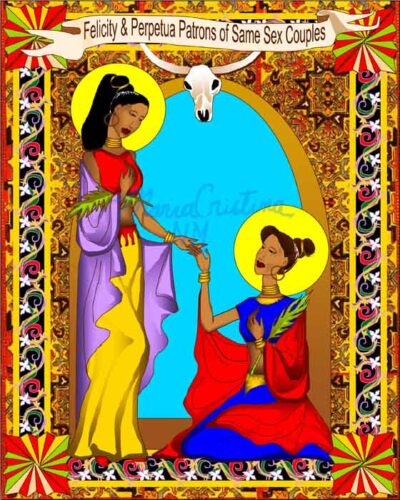
“Felicity and Perpetua: Patrons of Same-Sex Couples” by Maria Cristina
A banner saying “patrons of same sex couples” hangs above Felicity and Perpetua in the colorful icon painted by Maria Cristina, an artist based in Las Cruces, New Mexico. She paints the two women holding hands in an elegant gesture. The skull of a long-horn cow, similar to paintings of famous New Mexico artist Georgia O’Keefe, adds a welcome bit of Southwestern flavor to the image while echoing the standard iconography of portraying the pair with a cow.
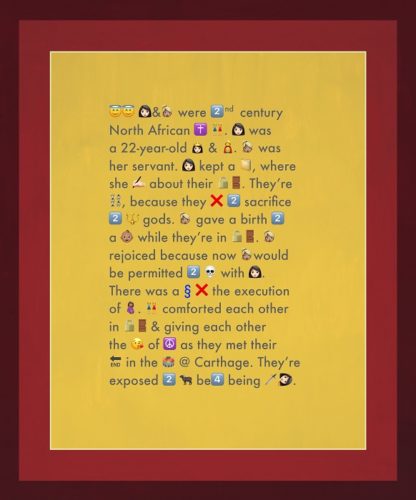
“New icon: Saints Perpetua and Felicitas” by Kalle Hamm
Finnish artist Kalle Hamm created an image of Perpetua and Felicitas that is suitable for society now, when “icon” is more likely to mean a computer symbol than a religious figure. He writes their story using emoji with the goal of affirming LGBTQ people in a contemporary, accessible way. Hamm’s 2018 “New Icons” series includes these and many other same-sex pairs of saints who suffered for their beliefs.
 Saints Perpetua and Felicity appear together as a couple on a religious medal available from PicturesOnGold at Amazon.
Saints Perpetua and Felicity appear together as a couple on a religious medal available from PicturesOnGold at Amazon.

Felicity and Perpetua by Jim Ru
Artist Jim Ru was inspired to paint Felicity and Perpetua as a kissing couple. His version was displayed in his show “Transcendent Faith: Gay, Lesbian and Transgendered Saints” in Bisbee Arizona in the 1990s.
Irish artist St. George Hare, painted an erotic, romanticized vision of Perpetua and Felicity around 1890. His painting “The Victory of Faith” shows the women as an inter-racial couple sleeping together nude on a prison floor.
Their lives are the subject of several historical novels, including “Perpetua: A Bride, A Martyr, A Passion” by Amy Peterson and “The Bronze Ladder
” by Malcolm Lyon.
Perpetua and Felicity prayers
Q Spirit’s Litany of Queer Saints includes these lines:
“Saints Perpetua and Felicity, who shared a kiss before dying, patron saints of same-sex couples, pray for us.”
Books on Perpetua and Felicity
Chapter “Transgender Saints: Perpetua’s Legacy” by Barbara Gold in “The Routledge Companion to the Reception of Ancient Greek and Roman Gender and Sexuality” (2022)
“Perpetua: Athlete of God” by Barbara Gold (Oxford University Press, 2018)
Links related to Perpetua and Felicity
Acts of Perpetua and Felicitas (Earlychristianwritings.com)
“Eternal Bliss” – SS Felicity and Perpetua, March 7th (Queer Saints and Martyrs – and Others)
Suspect 3rd Century Women Put to Death in Arena: Ancient Hate Crime? (Unfinished Lives: Remembering LGBT hate crime victims)
Facebook discussion of this article at Believe Out Loud
___
Translations:
To read this article in Spanish, to to:
Perpetua y Felicitas: santas patronas de parejas del mismo sexo (Santos Queer)
To read this article in Russian, go to:
Святые Перпетуя и Фелицитата: покровительницы однополых пар (nuntiare.org)
To read this article in Italian, go to:
Perpetua e Felicita, le sante patrone delle coppie omosessuali (gionata.org)
To read this article in Persian / Farsi, go to:
پرپتوا و فلیچیتاس (anastasius_sacredheart)
Oratio ad Christum Iris Arcus (Rainbow Christ Prayer in Latin)
___
Top image credit:
“Saints Perpetua and Felicity” by Brother Robert Lentz, OFM. Prints are available through Amazon and Trinity Stores.
___
This post is part of the LGBTQ Saints series by Kittredge Cherry. Traditional and alternative saints, people in the Bible, LGBTQ martyrs, authors, theologians, religious leaders, artists, deities and other figures of special interest to lesbian, gay, bisexual and transgender and queer (LGBTQ) people and our allies are covered.
This article has evolved and expanded greatly since the first version was posted in March 2010. It was published on Q Spirit in February 2017, was enhanced with new material over time, and was most recently updated on March 11, 2024.
Copyright © Kittredge Cherry. All rights reserved.
Qspirit.net presents the Jesus in Love Blog on LGBTQ spirituality.
____







Historical video of Perpetua and Felicity: https://www.youtube.com/watch?v=DI1nygKZ0GM&ab_channel=VisionVideo
I waited to watch the whole 30-minute video before approving it as a comment here. It does a good job of explaining the basics and the common understanding of the martyrdom of Perpetua and Felicity. However it downplays the parts that are most interesting to an LGBTQ audience. Almost everything is shown as a re-enactment — except the kiss between Perpetua and Felicity. For that the camera turns to the elderly male narrator as he quickly describes their kiss. The video also revises Perpetua’s vision of becoming a man, stating instead that she became as strong as a man.
This article claims Felicity and Perpetua were arrested and executed together (which you imply means they were lovers), which leaves out the fact that they were arrested along with a larger group that included several men (Revocatus, Saturninus and Secundulus), and likewise they were executed as part of a larger group; and their only known link to each other is the fact that one was the slave of the other. There is nothing to imply that they were lesbian lovers. The “kiss of peace” was a common practice that had nothing to do with romance, and hugging each other before they died is just a common reaction when facing a fearful situation. John Boswell’s opinions on this (and other issues) have been rejected by virtually all historians, including gay historians.
It is interesting that generally Kittredge Cherry, after writing this ‘clutching at straws’ fictional article, does not try to defend it by responding to those commentators who have a much more realistic grasp of the story and of our Creator God’s nature and of His intentions for His loved Creation. It is true that he loves us all, regardless of what we choose to be or become, as He knows we are sheep who are easily misguided and all He wants for us is to look to the Good Shepherd to be saved from ourselves. Perpetua and Felicity (not saints by the way any more than any one of us who God has called saints in the Biblical sense) would no doubt be mortified by what we have allowed them to become and I’m sure it all grieves God’s heart too. Remember who the real enemy is (as two of Perpetua’s visions made clear) and make sure we are fighting him and not being deceived by him into thinking lies are truth. We seem to have lost the rainbow, are we also to lose two of the most enduring testimonies of the strength of God-given Christian love which trancends the man-made boundaries of race, class, power and even death. Whoever reads this, God loves you and wants the best for you, but you must know that His idea of the best for you far exceeds your own limited idea of what is best for you.
I myself painted a por trait of SS Felicity and Perpetua(I’m an artist) as two black women!
Terry, how can we see your portrait of Saints Felicity and Perpetua as black women? Is it posted online? I am interested in adding it to this article about them. Blessings to you and your artwork!
Thank you for the information about Saints Perpetua and Felicita. Perpetua was married and had a child. Felicita was pregnant when she was killed. Neither of them were lesbian. You see two women hugging and that’s all you need to erect a shameful lie about their sexual orientation. It’s a shame that you’re so desperate to validate your position that you would fabricate such an atrocious story. Please seek help, IMMEDIATELY.
I truly respect homosexuals and deeply love them. But this article is nothing else like just one big make up, it is a total fake. Those two saints lived in the time when Christianity was opposed to the pagan world. Homosexuality was very popular in the culture back there. Those who decided to be Baptized had to reject the homosexual behaviors. The Echo of it is found in Saint Paul’s letters and the first Christian writings.
It is so sad how manipulated this article is, far, far from the truth
Why have you changed their ethnicity? They were north African and would have looked like north Africans and north Africans do not look like sub-saharan Africans. The Ravena mosaic shows what they would have looked like. I appreciate that people want to ensure that black Africans have a proper place in the history of the Church and rightly so but that isn’t accomplished by taking anyone from history and just changing them into someone who is black when they clearly would not have been.
The Ravenna Mosaics were created centuries after Perpetua and Felicity died. How would the artist know what they looked like? They are also portrayed as very pale, which would be incorrect in any case. They were from Carthage which is in modern day Tunisia. North Africans are a very diverse people and are able to have a variety of skin tones, including ones which we might call black. In fact, modern day Tunisia has a sizable black population. It is still in Africa, after all.
god’s love! Like Rumi and shams in Islam
I agree! I also wrote a blog article about Rumi and Shams titled “Rumi: Poet and Sufi mystic inspired by same-sex love.”
Where do we find evidence that St. Perpetua and St. Felicity are lesbian? Homosexuality is against the Christian religion (which they both died for) because it is contrary to the way God created humans of the opposite sex to love each other and create and nurture new life within that love. The love between St. Perpetua and St. Felicity was a sisterly love.
Agreed! To say that they are patronesses of lesbians is not in accordance with the law of God! Besides, only special theologians are allowed to designate the patronage of a Saint. You can spiritually adopt them as an individual to intercede for you. You can love them and admire them for who they actually were, not whom you seek them to be. May God give you grace to follow Him as He has written.
If homosexuality goes against christianity, then riddle me this. God created everyone in the universe exactly how he wanted them to be. If he does not love gay people, then why would he create them that way? There is nothing wrong with being gay, and there are lots of devout christians who are.
What is so astonishing about these women is that their love for Christ was so strong that they were willing to die a horrible death, even leaving behind their own babies. As a Christian mother of 4, I’m not sure that I could do that. That’s what’s so admirable about these two women; their love of Christ. Their devotion to God is the only thing we should be trying to emulate and admire about these characters.
I am trying to find out where the image at the top of this page originally comes from. Do you have any idea/
Yes, the top image is “Saints Perpetua and Felicity” by Brother Robert Lentz, OFM, from http://www.trinitystores.com. The image credit is also listed at the end of my post. It’s a beautiful icon, isn’t it?
Saint Perpetua didn’t write about her relationship with Felicity, that was added after their martyrdom. The kiss of peace is not romantic, it is the peace of Christ. Also, these women were both mothers, the result of sex with a man—so with this obvious evidence against lesbianism, and zero evidence for lesbianism, it strikes me as odd that modernists have inserted that into their story.
Lots of Lesbians have had sex with men and had children. Bisexuals also exist.
Did you know that St. Felicity couldn’t be executed before giving birth? The Romans considered unborn life sacred. Hmmm…even those barbarians weren’t as barbaric as we are today. St. Perpetua had a baby who was allowed to be with her in prison and we know St. Felicity had a child in prison before she was executed.Homosexuals? I think not. Hint:women can have close friends without being lesbos.
I am writing a graphic novel about the Roman emperor Septimius Severus and I want to cover the passion of Perpetua and Felicity as Severus’ wife and younger son feature in the story- I really want to focus on Perpetua and Felicity as LGBT martyrs (possibly interracial too!) I guess the only thing that really bothers me is Perpetua owning Felicity as her slave- if you could give me any guidance as to how to portray this as a story of compassion and devotion I would be much obliged.
This sounds like a great project, Doug! Please let me know when your graphic novel is published. I already put all the best info I have on the devotion between Perpetua and Felicity into my blog article.
If you want to know more, I suggest going back to the original source: “The Passion of St. Perpetua, St. Felicitas, and their Companions,” the original prison diary written by Saint Perpetua and edited by Tertullian. It is available in many versions, including this one:
“ The Martyrdom of Perpetua and Felicity: and other writings ” by Tertullian of Carthage (Author), R. E. Wallis (Translator), S. Thelwall (Translator)
I pray that the saints will not hold all those lies you wrote for them against you on that day …
And quoting the words of Satouros who died on the same day with Perpetoua and Felicita: “Remember very well the faces of those saints, because you may come across them on that day …”